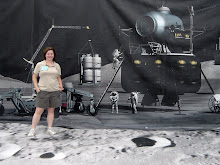So you’ve all heard, at one point or another, news reports of big fireballs streaking through the sky or of rocks falling from space and punching holes in cars or causing injuries or damage. But those news reports are like twice a year, and halfway across the world from you, and you want to find a meteorite now.
I swear again, I do not plant these questions, but I just put up a new web page a couple of weeks ago, on New Mexico Meteorites, because we get a lot of questions about how to go meteorite hunting. Basically, it takes a lot of patience and time, and you need to be super-careful about whose land you’re on. Other than that, anyone can hunt meteorites. They’re basically irregularly shaped rocks with a black fusion crust and are heavy and magnetic. Unfortunately, that description also fits an awful lot of terrestrial rocks, so check out my other web page on How to Identify a Meteorite, including some easy tests you can do at home. And no, ANSMET team members don’t need to be familiar with meteorites to find black rocks on the ice, but the ANSMET program is funded for scientific purposes by NASA and NSF, so meteorite scientists get first crack at being team members, and as you might guess, there’s no shortage of volunteers from our community, though the project has also taken teachers, writers, photographers and astronauts.
What do you do with a meteorite when you find it? There’s (usually) nothing sketchy about private meteorite hunters. There are lots of people willing to pay for meteorites and if you take the time and money to find one legitimately, you can sell it on the open market. Meteorite hunters and scientific institutions have historically formed a partnership that benefits both of them – scientific institutions will classify and certify the meteorite’s authenticity in return for 20g or 20% of the mass of the meteorite, whichever is smaller. This allows hunters to sell authentic meteorites and scientists to retain pieces for study. In recent years, however, there’s growing concern about private meteorite hunting and selling both from a scientific point of view (frequently, the piece in scientific hands is unrepresentative and we don’t have the money to buy more pieces to really understand the rock) and from an ethical point of view (many meteorites are smuggled out of developing countries in Africa and the Arabian Peninsula by bribing local militias).
I’ll be going down to Texas in a couple of weeks (with explicit, written permission from the landowner) to field test some new equipment we here at the IOM got for meteorite recovery efforts if someone calls us and says they saw a fall, which people often do because the southwestern skies are big and clear. Metal detectors are good at finding meteorites among terrestrial rocks, but can be a pain because they also pick up a lot of spent ammo, aluminum foil and cans, and smelter slag. We’re also bringing a quick chemical test for nickel, with which we’ve had mixed results in lab testing, and a magnetic susceptibility meter, which measures the percentage of magnetic metal in the rock and seems to do a good job of distinguishing meteorites from slag.
Subscribe to:
Post Comments (Atom)

1 comment:
Riddle me this science girl....
What is making comet swan appear green?
Post a Comment